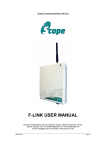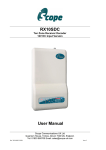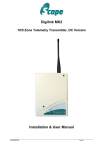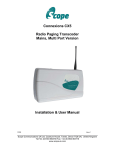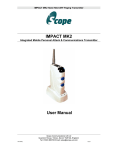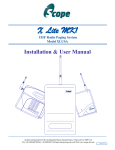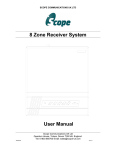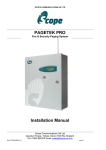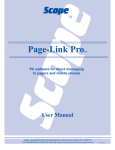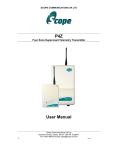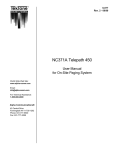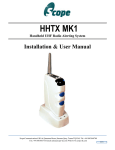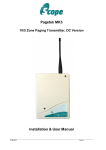Download F-LINK MK2 USER MANUAL
Transcript
Scope Communications UK Ltd F-LINK MK2 USER MANUAL Scope Communications UK Ltd, Quantum House, Steamer Quay Rd, Totnes, Devon TQ9 5AL Tel: +44 (0)1803 860700 Fax: +44 (0)1803 863716 Email: [email protected] Web: www.scope-uk.com Ref: FLNK2 Issue 3 F-Link Supervised Transceiver System CONTENTS Preface 3 Introduction 6 Hardware Configuration 7 Installation & Operation 12 Specification 16 Ref: FLNK2 Page 2 of 16 Issue 3 F-Link Supervised Transceiver System PREFACE Important Installation Information It is the purchasers’ responsibility to determine the suitability of this equipment and its derivatives for any given application, Scope cannot give specific advice in this manual, as each use will require independent evaluation. Scope has, wherever possible, employed extra safeguards to monitor the system’s performance. Certain system installations, operational requirements or budgets may, however, limit the effectiveness of these safeguards. Again, the suitability of the system for any given application must therefore be decided by the installer and their customer, relative to the application and risk. Good working practice dictates that a suitable system installation log must be generated, together with a record of the dates when the system has been manually checked, (with the aid of signal strength meters etc.) enabling the system performance to be compared with the original installation data. For UK equipment, Scope has no control of the use and application of the frequencies issued by OFCOM. Some equipment that is licensed may have greater protection than other equipment which is operated on a WT Act License Exempt basis. The supply of this equipment is governed by our standard terms and conditions of sale, which can be found on the reverse of all order acknowledgements*, proforma invoices*, delivery notes, price lists and invoices. Alternatively, these can be provided on request. * Faxed proforma invoices and quotations refer to “conditions available upon request”. Important Safety Information Scope products are designed to operate safely when installed and used according to general safety practices. The following requirements should be observed at all times. Do NOT subject this equipment to: Mechanical shock Excessive humidity or moisture Extremes of temperature Corrosive liquids This equipment is designed for indoor use, unless expressly stated otherwise, and must not be used in classified Hazardous Areas, including areas containing explosive or flammable vapours, unless express authorisation has been given in Ref: FLNK2 Page 3 of 16 Issue 3 F-Link Supervised Transceiver System writing by the manufacturer. If in doubt, consult your local product dealer for further information. Do not obstruct any slots or openings in the product. These are provided for ventilation to ensure reliable operation of the product and to protect it from overheating. Only use a damp cloth for cleaning (not liquid or aerosol based cleaners), and ensure that any power is removed from the unit prior to beginning the cleaning operation. Removal of covers from the equipment must only be undertaken by authorised service personnel, who must ensure that power is isolated prior to removal. Installation Installation must only be undertaken by an Approved contractor, who shall ensure that all work is carried out in compliance with National Wiring Regulations. For mains powered equipment, a readily accessible isolating fuse or switched socket must be located within 1 metre of the equipment. No User Serviceable Parts Alteration or modification to any part of this equipment, without the prior written consent of the manufacturer, will invalidate all Approvals and Warranties attaching to the equipment. Further liability for the operation of the equipment, under the applicable law, will pass to the user, who will absolve the manufacturer of any further responsibility for it’s correct operation and use. Liability Scope does not accept liability for any damage or injury, howsoever caused as the result of misuse of this equipment. It is the responsibility of the user to ensure that the equipment is operated in the manner for which it was intended and that it is the correct item of equipment for the required task. Warranty This product is warranted as free from defects of workmanship and materials for a period of one year from the original purchase date. During this time, if there is a defect or malfunction of this product, Scope will, with proof of purchase, repair or replace at it’s discretion any defective parts, free of charge. This does not include where the adjustments, parts and repair are necessary due to circumstances beyond the control of Scope, including but not limited to fire or other casualty, accident, neglect, abuse, abnormal use or battery leakage damage. Ref: FLNK2 Page 4 of 16 Issue 3 F-Link Supervised Transceiver System WARNING! No User Serviceable Parts Alteration or modification to any part of this equipment, without the prior written consent of the manufacturer, will invalidate all manufacturer approvals and warranties. No adjustments can be undertaken except by qualified and licensed persons as authorised by Scope. This product complies with the essential requirements of the R&TTE Directive 1999/5/EC Copies of the Declaration of Conformity covering this product can be obtained from Scope at: Quantum House, Steamer Quay, Totnes TQ9 5AL United Kingdom. Do not discard. At end of life this equipment must be sent to an authorised waste treatment centre. Contact Scope at the above address for further details. © Scope Communications UK Ltd, 2011 All Rights Reserved Ref: FLNK2 Page 5 of 16 Issue 3 F-Link Supervised Transceiver System Introduction The Scope F-Link system is a four input (dry contact) transceiver which forms part of a linked radio network for remote alerting and status monitoring, typically of fire or security panels. The unit has 4 dry contact input zones, each with a corresponding relay output and a further relay to indicate a radio or monitored cable link failure. The unit can be configured as either a "master" or a "node" in a supervised private radio network, employing polling, acknowledge-back and "listen-before-talk" (LBT) techniques to ensure robustness and reliability of the radio system. The front panel indicates when any zones are active, the unit's configuration status (master/node), the presence of a radio signal jam or radio link fail and received signal strength of incoming transmissions. The F-Link™ Wireless Networking Protocol is a simple protocol designed for low data rate, short distance communication. Fundamentally based on IEEE 802.15.4™, the F-Link protocol provides an easy-to-use plug-and-play wireless network of up to 3 "nodes" + a "master" unit in it's standard configuration. Expanded systems of up to 15 nodes are possible for specialist applications. Please refer to Scope Technical Sales for further details. User-configurable options include Normally Open/Closed default condition for each input zone and relays set as either Latching, Change of State or Self Reset (momentary), all selectable via a bank of switches within the unit (no PC programming required). The input power requirement is 10-30V dc (500 mA minimum supply), allowing the unit to be powered from a typical 12V or 24V dc panel supply. The transmitter is a 0.5W synthesized unit, factory programmable between 458.500 MHz and 458.650 MHz in 12.5KHz channels. Ref: FLNK2 Page 6 of 16 Issue 3 F-Link Supervised Transceiver System Hardware Configuration Input Power is applied through a 2 way latching connector (supplied) and can be between 10 – 30V dc @ 500mA minimum. A miniature push switch (and two way terminal in parallel) is also provided internally for system reset. 4 non-voltage input zones are provided and can be configured for Normally open or Normal Closed operation. Each Zone has a corresponding Relay output. Each relay output can be configured as latching, Change of state, or Self reset. A fifth relay is provided for a radio or monitored cable link fail detection. A monitored cable link input "FP Link" (connector J10) is provided which will trigger the Link Fail light & relay if a suitably connected cable loop either goes open or short circuit. To use this feature, remove the resistor (R26, 680 Ohms) from the 2 terminals and connect it between 2 free cores in a multi-core cable, at the end of the link cable furthest away from the F-Link unit. At the F-Link end of the cable, connect the 2 cores to the terminals of J10 in the F-Link unit (see diagram below). WARNING! If cable link monitoring is not required, ensure the resistor is securely connected across the 2 terminals of J10 (as supplied), otherwise the Link Fail will activate continuously. A USB port is also provided for factory configuration and future interface applications. The Dip switches provided on board allow the user to Configure the Input Type, the behaviour of the Relays and the NETID (network identity) of the radio device. SW1 1-4 controls the input type, SW1 5-8 control the NETID, and SW2 1-2 control the relay behaviour. These settings are shown below in the following tables. Ref: FLNK2 Page 7 of 16 Issue 3 F-Link Supervised Transceiver System Note: the device is configured to use the DIP switches on Power Up, so any changes to these settings must be done with power removed (or power unit down then back up again after making changes). Table 1: Input Zone Settings Switch State SW1 DIP 1 Off Zone 1 Input is Normally Open. On Zone 1 Input Is Normally Closed. Off Zone 2 Input is Normally Open. On Zone 2 Input Is Normally Closed. Off Zone 3 Input is Normally Open. On Zone 3 Input Is Normally Closed. Off Zone 4 Input is Normally Open. On Zone 4 Input Is Normally Closed. SW1 DIP 2 SW1 DIP 3 SW1 DIP 4 Zone Behavior Table 2: NETID Settings NETID SW1 DIP5 SW1 DIP6 SW1 DIP7 SW1 DIP8 0 ON ON ON ON Master 1 ON ON ON OFF Node 2 ON ON OFF ON Node 3 ON ON OFF OFF Node 4 ON OFF ON ON Node 5 ON OFF ON OFF Node 6 ON OFF OFF ON Node 7 ON OFF OFF OFF Node 8 OFF ON ON ON Node 9 OFF ON ON OFF Node 10 OFF ON OFF ON Node 11 OFF ON OFF OFF Node 12 OFF OFF ON ON Node 13 OFF OFF ON OFF Node 14 OFF OFF OFF ON Node 15 OFF OFF OFF OFF Node Ref: FLNK2 Page 8 of 16 Comments Issue 3 F-Link Supervised Transceiver System Table 3: Relay Settings. Relay Output SW2 DIP 1 SW2 DIP 2 Comments Momentary OFF OFF Default Set time = 30 secs Change of State OFF ON Zone Input Changes the state of the Relay. Change of State ON OFF Zone Input Changes the state of the Relay. Latching ON ON Requires Power Down to Reset. Note: if the input zones are configured as Normally Closed, ensure the contacts are connected and in the correct (closed) state on power up, otherwise the unit will detect that a change has occurred and a resultant zone message will be transmitted. If the Link Fail relay is activated, it will remain in the active state until the unit is put into Discover/Join Mode or the unit has re-established contact with a master/node, or the FP Link cable monitor line is restored. Re-establishing contact involves a successful poll message. Ref: FLNK2 Page 9 of 16 Issue 3 F-Link Supervised Transceiver System Diagram 1: Interconnect and Switch Layout Ref: FLNK2 Page 10 of 16 Issue 3 F-Link Supervised Transceiver System Diagram 2: Front Panel Display The front panel display provide the user with a visual indication of the current unit's state. Each Zone has an indicator that is lit whenever the associated relay is activated. Each time a unit attempts to transmit it “Listens” to the Channel on which it is set. If it determines that an interfering signal is present then the transmitter will be inhibited until the interference clears. Every time a signal is blocked then a counter is incremented. If 128 consecutive transmissions are blocked then this will trigger a Signal Jam. A "Link Fail" indicator lights and activates the Link Fail relay* if the unit cannot communicate with other units to which it was previously connected. When the unit is set as a node this means that it has joined a network and has not received any poll messages within a set time out (default is approx. 4 minutes). When the unit is set as a master this indicates that the device cannot communicate with at least one node that it is connected to. This time out value is also set at approx. 4 minutes. * this will also activate the light & relay if the "FP Link" cable monitor line goes either short or open circuit. A Transmit indicator lights when a transmission is in progress. A Master/Node indicator lights when the unit is set as a Master. This also indicates if it is in "Discover" mode when configured as a Master or "Join" mode when configured as a node by flashing. A master will continue to flash for 3 minutes while a node will stop flashing the indicator when it has joined a network. A Reset indicator confirms that the unit is in reset. The RSSI (Received Signal Strength Indicator) display performs a number of functions. If the display is periodically blinking all the leds then this indicates that the unit has not joined a network or has no other units connected to it. Ref: FLNK2 Page 11 of 16 Issue 3 F-Link Supervised Transceiver System When indicating an RSSI value, the received value is displayed as a level for a period of 2 seconds then the highest level indicator is kept lit. The level meter follows the convention of: Red = low Yellow = Average Green = High The RSSI level is refreshed every time a message is received from a valid transmission within the network (it will not display received signals from other transmitters not logged onto the network). A blue led indicates power to the device. Installation and Operation Siting of the hardware Before locating the hardware in any given location, it is important to take into account the range of operation that you require to obtain from your system. The standard transmitter can quite easily provide ranges of up to a mile or more and will provide excellent propagation on most sites, covering a considerable area with just a 1/4 wave helical antenna (standard supplied) connected directly to the unit. For coverage where difficult operating conditions exist, it may be advantageous to install a remote antenna. Installing the transmitter on the second or third floor of a building will more often than not boost overall range. However, horizontal range is not always required as much as propagation through a multi storey building. Here it may be more useful to use a small external antenna mounted outside the building at half the building height. Sometimes range is required more in one direction than in the other: moving the aerial to one side of the building can provide a bias in the required direction, which may overcome the range difficulties. The LUHF is a remote mounted mini dipole antenna ideal for indoor use, supplied with a 5 mtr feeder cable. Specify SMC connector termination for use with the F-Link. Important: coaxial feeds greater than 5 metres must employ low loss 50 ohm coax. We normally do not recommend feeds of more than 15 metres for standard applications. However, we suggest you contact our technical dept where other considerations may prove this to be impractical. A further consideration is the distance between the transmitter and the source of the trigger. Dry contact cables should preferably be of the shielded type and kept as short as possible, no more than 3 metres, and kept away from any other cabling, especially mains & data cables, to avoid potential interference. Ref: FLNK2 Page 12 of 16 Issue 3 F-Link Supervised Transceiver System Some major points to consider when installing equipment: 1 Never install antennas near or adjacent to telephone, public address or data communication lines or overhead power cables. 2 Avoid, where ever possible, running antenna coax alongside other cables. 3 Avoid mounting the transmitter in the immediate vicinity of telephone exchanges or computer equipment. 4 Always use proprietary 50 ohm coaxial cable between the antenna and the transmitter. If cable runs exceed 5 metres, always use low loss 50 ohm cable such as RG213, UR67 or equivalent. Coaxial cable intended for TV, Satellite or CCTV installations is normally 75 OHM and therefore totally unsuitable for any transmitter installation manufactured by Scope. 5 Also remember that the performance of the system will be effected by the type of material the unit is mounted on and its surroundings. The following is a list of materials that this transmitter will be adversely affected by if mounted on or if mounted in close proximity to: a) b) c) d) Foil back plasterboard Metal mesh or wire reinforced glass Metal sheeting, large mirrors or suspended ceilings Lift shafts All of the above can reflect radio waves and thereby reduce the capability of the transmitter to perform its desired functions. 6 The circuit boards within this equipment may be harmed by Electrostatic Discharge (ESD). Installers should ensure that both themselves and the system’s chassis are grounded before beginning any installation, and should ensure that adequate anti-static procedures are adhered to at all times. 7 Warning! Never transmit without an aerial attached to the transmitter Ref: FLNK2 Page 13 of 16 Issue 3 F-Link Supervised Transceiver System Master F-Link unit In any F-LINK network only 1 device can be configured as a Master. A unit is configured as a Master when the address is set as 0 (See Dip switch settings above). Any device that is not address 0 will be set as a Node. Ensure that ALL units have been configured (as per "Hardware Configuration" section above) before proceeding with the next stage: Joining the Network Unscrew & lift off the front cover from all the units, taking care not to pull or snag the front panel cable, and place alongside the units. Apply power to the Master and the unit will start a Relay and Led check. All leds will be lit (except the reset led) and all the relays will toggle in number order. The RSSI indicator will be fully lit, then set the highest Led. The Power Led will remain lit and if configured as a Master, the Master Led will be lit. The Signal Jam, Link Fail and Reset leds will all be off. Press and hold SW3 on the Master interface board until the Master/Node Led begins flashing. This puts the Master into Discover mode and ready to accept requests from Nodes to join the network. This mode is time limited to 3 minutes. After this time the Master/Node Led will stop flashing and the Master will not accept any requests from Nodes to join the network. Power up the Node units, which will sequence through the relay & Led check. Once completed, press and hold SW3 on the interface boards of all the Nodes that are required to join the network until the Master/Node Led begins flashing. This puts the Nodes into Join mode and they will begin to transmit to the Master to request to join the network. They attempt to join the network for up to 3 minutes. Once the Nodes have received a reply from the Master that they have been joined to the network, the Master/Node Led on the Nodes will stop flashing indicating that they are now linked to the Master. The Master will now begin the process of monitoring all devices connected. The front panel display on all units will indicate the RSSI levels of received signal strength. The Master keeps a list of devices linked to it's network and periodically polls each device to check that it is still on line. The Master controls the schedule and polling order. When a transmission occurs the Transmit led will be lit. Whenever a signal is Ref: FLNK2 Page 14 of 16 Issue 3 F-Link Supervised Transceiver System received the RSSI indicator will illuminate depending on signal strength and keep the highest led value lit to indicate the signal strength of the last received signal. If a Node unit does not receive a network poll from the Master within 3 minutes then the Link Fail Led will be lit and the Link Fail Relay will activate. If a connection is reestablished then this will reset itself. Note that a Master will set it's Link Fail relay if it cannot establish a link with one or more of it's connected Nodes. That means that if 2 nodes are connected to a Master and the Master can only talk to one of them, then the Master unit's Link Fail light and relay will activate. Clearing Nodes can be cleared from the network by powering down the node, shorting pins 1 & 5 of connector J3 on the LEM radio module, then powering it back up again. After the unit has finished it's diagnostic routine the link should be removed. The RSSI indicator should no longer activate in response to polling transmissions from the Master, confirming that it has been cleared from the network. A Master can clear it's entire Node list by proceeding as above. The Master will then send a broadcast message to all Nodes in the network, which will disconnect themselves and all units will act as though unconnected. Operation & Functions Each unit has 4 dry contact inputs. These can be set as normally open or normally closed (See Dip switch settings above). If the inputs are triggered then the corresponding Zone led will be lit and the corresponding Zone Relay energised / deenergised depending on the Dip switch settings. The Unit activated will transmit this information over the network. The Master will then ensure that all Node units in the network receive the triggered Zone information and the corresponding Zone indicator & relay on all units in the network will be set. The Reset line can be operated by connecting a non voltage switch between the terminals on the interface module (see Diagram 1, J8 connector). This allows the user to independently reset the relays to their default positions. Note: if the Reset is operated on the Master unit, both the Master and all the Nodes will have their relays reset to the default position. Where operated on a Node, just the relays on that Node will be reset. If any unit cannot transmit due to the continual presence of a clashing signal, a Listen Before Talk protocol operates and the Signal Jam indicator will light. Ref: FLNK2 Page 15 of 16 Issue 3 F-Link Supervised Transceiver System Specification Input Voltage: 10-30V dc Power Consumption: zone) <50mA operating, 300mA transmit (+25mA per active Transmitter: Power output: 500mW max Frequency Range: 458.500 to 458.650 MHz Channel Spacing: 12.5KHz Adjacent Channel: better than 10uW @ 2 KHz deviation TX Baud Rate: 2400 Baud Receiver: Sensitivity -100dBm Radio Standards: ETS EN 300 220 Notified Body No. 0891 EMC Standards: ETS EN 301 489 Safety Standards EN 60950 Ports: 4 dry contact Zone inputs (configurable) 4 relay Zone outputs (configurable) 1 relay output for Link Fail indication USB port for programming/interface function DIP switches for system configuration Footprint (mm): 184 (L) x 138 (W) x 45 (D) max excluding aerial Scope’s policy is one of continuous development and specifications are subject to change without prior notice Ref: FLNK2 Page 16 of 16 Issue 3
















